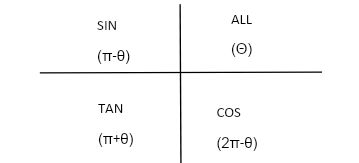
Find the value of cos (135°).
Answer
547.5k+ views
Hint:There are 4 quadrants in the trigonometric plane. Figure out in which quadrant does the given angle lie on. ALL, SINE, TAN, COS are positive in the order of quadrant 1,2,3 and 4 anticlockwise. The rest trigonometric functions are negative.
Complete step by step solution:
135° clearly lies in the 2 nd quadrant. All trigonometric functions except “sine” are negative in the 2 nd quadrant.

Let, 135° = Θ.
As we can see that whenever the required angle (Θ) is in 2 nd quadrant, we can write the angle as (π-
θ).
Therefore, cos (135°) = - cos (π-135°)
We know that π= 180°
∴ cos (135°) = - cos (π-135°) = - cos (180°−135°)
= - cos (45°)
= $ - \dfrac{1}{{\sqrt 2 }} $
Alternate method: Instead of the above steps, you might also write cos (135°) as the sum of two standard angles,
cos (135°) = cos (45°+90°)
Using the formula, cos (A+B) = cos A. cos B – sin A. sin B
= cos 45°. cos 90° - sin 45°. sin 90°
= $ \dfrac{1}{{\sqrt 2 }} $ . 0 - $ \dfrac{1}{{\sqrt 2 }} $ . 1 = - $ \dfrac{1}{{\sqrt 2 }} $
Note: Whenever there are trigonometric calculations to be done, the quadrants must be kept in mind. The signs play a major role in determining the correct answer. One might use the first approach to write in exams, and the second approach when such short questions are given to be answered in a very short time.
Complete step by step solution:
135° clearly lies in the 2 nd quadrant. All trigonometric functions except “sine” are negative in the 2 nd quadrant.

Let, 135° = Θ.
As we can see that whenever the required angle (Θ) is in 2 nd quadrant, we can write the angle as (π-
θ).
Therefore, cos (135°) = - cos (π-135°)
We know that π= 180°
∴ cos (135°) = - cos (π-135°) = - cos (180°−135°)
= - cos (45°)
= $ - \dfrac{1}{{\sqrt 2 }} $
Alternate method: Instead of the above steps, you might also write cos (135°) as the sum of two standard angles,
cos (135°) = cos (45°+90°)
Using the formula, cos (A+B) = cos A. cos B – sin A. sin B
= cos 45°. cos 90° - sin 45°. sin 90°
= $ \dfrac{1}{{\sqrt 2 }} $ . 0 - $ \dfrac{1}{{\sqrt 2 }} $ . 1 = - $ \dfrac{1}{{\sqrt 2 }} $
Note: Whenever there are trigonometric calculations to be done, the quadrants must be kept in mind. The signs play a major role in determining the correct answer. One might use the first approach to write in exams, and the second approach when such short questions are given to be answered in a very short time.
Recently Updated Pages
Why are manures considered better than fertilizers class 11 biology CBSE

Find the coordinates of the midpoint of the line segment class 11 maths CBSE

Distinguish between static friction limiting friction class 11 physics CBSE

The Chairman of the constituent Assembly was A Jawaharlal class 11 social science CBSE

The first National Commission on Labour NCL submitted class 11 social science CBSE

Number of all subshell of n + l 7 is A 4 B 5 C 6 D class 11 chemistry CBSE

Trending doubts
What is meant by exothermic and endothermic reactions class 11 chemistry CBSE

10 examples of friction in our daily life

One Metric ton is equal to kg A 10000 B 1000 C 100 class 11 physics CBSE

1 Quintal is equal to a 110 kg b 10 kg c 100kg d 1000 class 11 physics CBSE

Difference Between Prokaryotic Cells and Eukaryotic Cells

What are Quantum numbers Explain the quantum number class 11 chemistry CBSE




